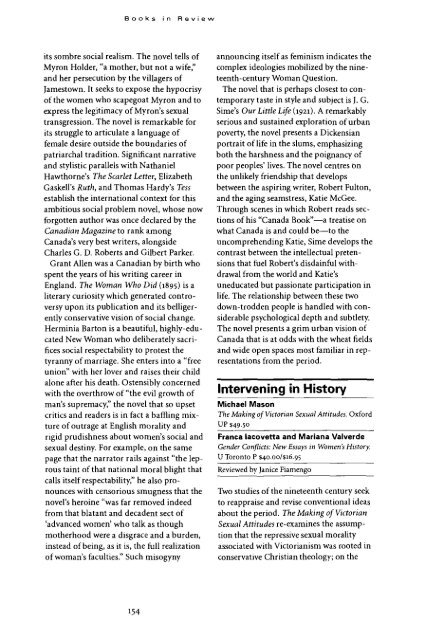A Quarterly of Criticism and Review i^^^^^^^^fcEjfc $15
A Quarterly of Criticism and Review i^^^^^^^^fcEjfc $15
A Quarterly of Criticism and Review i^^^^^^^^fcEjfc $15
Create successful ePaper yourself
Turn your PDF publications into a flip-book with our unique Google optimized e-Paper software.
Books in <strong>Review</strong>its sombre social realism. The novel tells <strong>of</strong>Myron Holder, "a mother, but not a wife,"<strong>and</strong> her persecution by the villagers <strong>of</strong>Jamestown. It seeks to expose the hypocrisy<strong>of</strong> the women who scapegoat Myron <strong>and</strong> toexpress the legitimacy <strong>of</strong> Myron's sexualtransgression. The novel is remarkable forits struggle to articulate a language <strong>of</strong>female desire outside the boundaries <strong>of</strong>patriarchal tradition. Significant narrative<strong>and</strong> stylistic parallels with NathanielHawthorne's The Scarlet Letter, ElizabethGaskell's Ruth, <strong>and</strong> Thomas Hardy's Tessestablish the international context for thisambitious social problem novel, whose nowforgotten author was once declared by theCanadian Magazine to rank amongCanada's very best writers, alongsideCharles G. D. Roberts <strong>and</strong> Gilbert Parker.Grant Allen was a Canadian by birth whospent the years <strong>of</strong> his writing career inEngl<strong>and</strong>. The Woman Who Did (1895) is aliterary curiosity which generated controversyupon its publication <strong>and</strong> its belligerentlyconservative vision <strong>of</strong> social change.Herminia Barton is a beautiful, highly-educatedNew Woman who deliberately sacrificessocial respectability to protest thetyranny <strong>of</strong> marriage. She enters into a "freeunion" with her lover <strong>and</strong> raises their childalone after his death. Ostensibly concernedwith the overthrow <strong>of</strong> "the evil growth <strong>of</strong>man's supremacy," the novel that so upsetcritics <strong>and</strong> readers is in fact a baffling mixture<strong>of</strong> outrage at English morality <strong>and</strong>rigid prudishness about women's social <strong>and</strong>sexual destiny. For example, on the samepage that the narrator rails against "the leproustaint <strong>of</strong> that national moral blight thatcalls itself respectability," he also pronounceswith censorious smugness that thenovel's heroine "was far removed indeedfrom that blatant <strong>and</strong> decadent sect <strong>of</strong>'advanced women' who talk as thoughmotherhood were a disgrace <strong>and</strong> a burden,instead <strong>of</strong> being, as it is, the full realization<strong>of</strong> woman's faculties." Such misogynyannouncing itself as feminism indicates thecomplex ideologies mobilized by the nineteenth-centuryWoman Question.The novel that is perhaps closest to contemporarytaste in style <strong>and</strong> subject is J. G.Sime's Our Little Life (1921). A remarkablyserious <strong>and</strong> sustained exploration <strong>of</strong> urbanpoverty, the novel presents a Dickensianportrait <strong>of</strong> life in the slums, emphasizingboth the harshness <strong>and</strong> the poignancy <strong>of</strong>poor peoples' lives. The novel centres onthe unlikely friendship that developsbetween the aspiring writer, Robert Fulton,<strong>and</strong> the aging seamstress, Katie McGee.Through scenes in which Robert reads sections<strong>of</strong> his "Canada Book"—a treatise onwhat Canada is <strong>and</strong> could be—to theuncomprehending Katie, Sime develops thecontrast between the intellectual pretensionsthat fuel Robert's disdainful withdrawalfrom the world <strong>and</strong> Katie'suneducated but passionate participation inlife. The relationship between these twodown-trodden people is h<strong>and</strong>led with considerablepsychological depth <strong>and</strong> subtlety.The novel presents a grim urban vision <strong>of</strong>Canada that is at odds with the wheat fields<strong>and</strong> wide open spaces most familiar in representationsfrom the period.Intervening in HistoryMichael MasonThe Making <strong>of</strong> Victorian Sexual Attitudes. OxfordUP $49.50Franca lacovetta <strong>and</strong> Mariana ValverdeGender Conflicts: New Essays in Women's History.U Toronto P $4O.oo/$i6.95<strong>Review</strong>ed by Janice FiamengoTwo studies <strong>of</strong> the nineteenth century seekto reappraise <strong>and</strong> revise conventional ideasabout the period. The Making <strong>of</strong> VictorianSexual Attitudes re-examines the assumptionthat the repressive sexual moralityassociated with Victorianism was rooted inconservative Christian theology; on the154
















